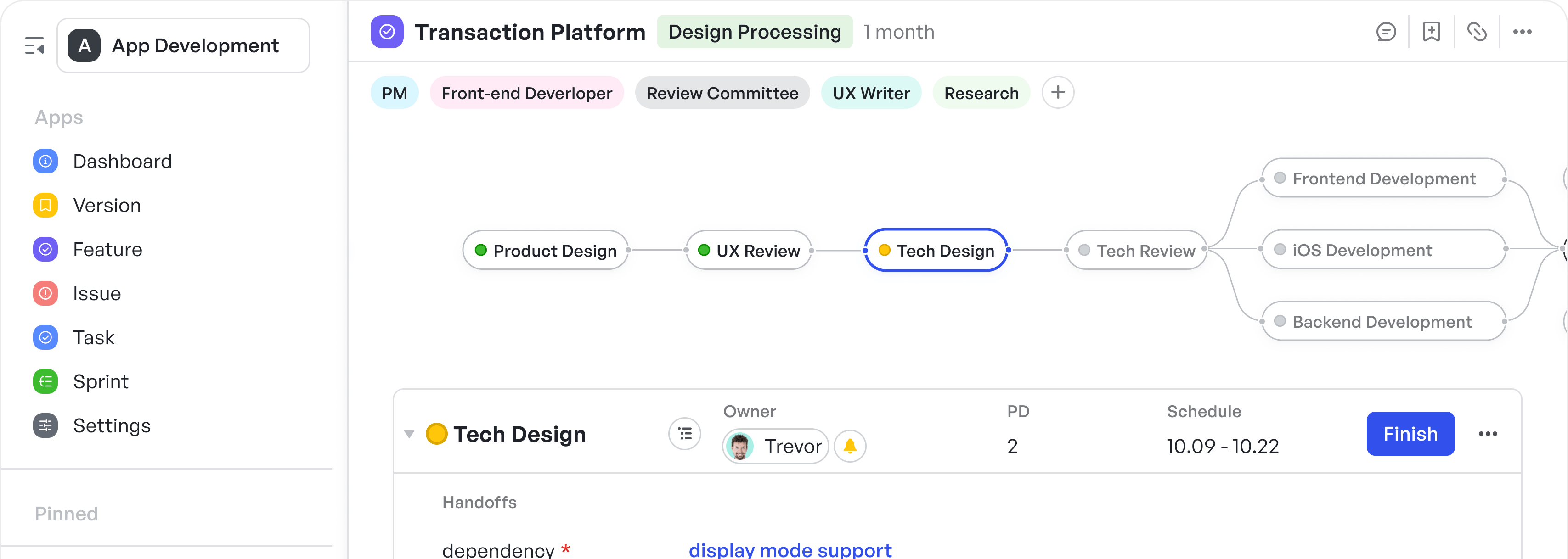As Antoine de Saint said, “A goal without a plan is just a wish,” this statement holds more relevancy when it comes to achieving the project goals. A successful project entails various elements – project planning being the most crucial one.
Project plans are essential to keeping projects organized and on track. With proper project planning, teams can stay informed about the goals, task timelines, and budget allocations for a project.
What goes into creating a successful project plan? What are the most common challenges while creating and executing a project plan?
Read this article as it talks about the importance of project planning and the challenges related to it. You’ll learn about creating a successful project plan with an example to guide you.
250px|700px|reset
加载中,请稍后
What is a Project Plan?
A project plan is a detailed roadmap of your project that outlines the goals, timeline, tasks, resources, and strategy for executing a project. It includes various aspects of projects, such as what needs to be done and by whom.
Anyone involved in the project can refer to the project plan at any stage. The most common elements of the project plan are the schedule, scope, due dates, and deliverables for all phases.
What is Project Planning?
Project planning is the second or third stage of the project management process, following project initiation and execution. It involves all the necessary details of your project, such as goals, scope, resources, and deliverables, to complete it.
Why is Project Planning Important?
Imagine a project with unclear goals & objectives, missing deadlines, and unallocated budgets. A project plan lays down the foundation for a successful project.
According to the PMI Institute, there is a strong correlation between project planning and project success. The better your plan, the better your outcome. Project planning holds immense importance for the project teams as it:
Optimizes resource allocation
Most failed projects have poorly allocated resources. According to McKinsey, 83% of business leaders credit proper resource allocation for the project’s success. Project resources such as human capital, financial assets, equipment, and content require careful planning and distribution to ensure that they align with the different roles.
Proper resource management also reduces workload, allowing managers to manage in real time. For example, a SaaS team has started a marketing campaign for a new product launch.
The project consists of various resources, including the project deliverables, financial assets, equipment, and prospect information. By allocating these resources to the different user roles, project managers can tap into the individual’s performance and enhance the project's performance.
Improves collaboration among team members
According to PMI, poor communication is a contributing factor in 56% of project failures. Good communication is essential for seamless project execution, irrespective of project size.
A project that involves multiple employees or teams, outsourced suppliers, and staff members in different time zones requires a project plan with communication channels and a language of communication.
A project plan considers the team’s communication needs, details the communication language, and prioritizes the most effective communication channels—email, messaging, calls, and others.
Enables goal tracking
Setting goals prior to a project clearly outlines expectations for the project managers and establishes accountability for the team. Clear goals and pre-defined objectives are also easier to translate into a quantifiable measure, making project tracking easier.
For example, a SaaS team is planning a new product launch. One of the project objectives is to complete 1,000 sign-ups in the first three months. Project leads can measure this goal during the project to see if it is executed correctly.
Continuous improvement
Continuous improvement is vital to a project’s success. It searches for ways to improve the project’s efficiency, productivity, and quality. A project plan facilitates continuous improvement by setting clear goals, defining user roles, and using quantifiable KPIs.
Project plans empower effective communication, reduce friction, and speed up the improvement process. Further, a project plan in a Gantt chart view notes down the positive, incremental changes across the organization.
These changes can be divided into different phases and assigned to the team members as their roles are defined.
Helps with employee retention
Project planning improves outcomes and employee satisfaction by reducing workload. Research shows that employees whose managers consistently acknowledge them for good work are five times more likely to stay at the company.
Also, clear communication between managers and employees is more likely to boost their involvement in the project. This ensures better project execution and makes team members feel valued.
How to Create a Project Plan in Six Simple Steps
250px|700px|reset
加载中,请稍后
Creating a detailed project management plan is a multi-step process that involves careful thought and strategic structuring. Irrespective of the project type, a project plan should follow this step-by-step approach:
- Define project goals and objectives
- Set project metrics
- Clarify stakeholders and assign roles
- Set a budget for your project
- Develop actionable tasks
- Establish an effective communication strategy
Step 1: Define project goals and objectives
Goals and objectives are two different elements of a project. Goals are the results a project team wants to achieve, whereas objectives are specific actions that help achieve these goals. A good idea is to jot down these goals and brainstorm the objectives, which can be converted into a quantifiable measure.
The goals and objectives are included in a project charter, which will be available throughout the project lifecycle.
Step 2: Set project metrics
Goals define the project's result, whereas project success metrics measure these results. Project metrics are a quantitative way to determine whether the team is on the right path to achieving the result. Leaders can use these metrics as a benchmark to track progress from beginning to end throughout the project.
For example, a goal for an event might be running an email campaign for four days. A success metric to track this goal might be having at least 500 newsletter sign-ups.
Step 3: Clarify stakeholders and assign roles
Every project has a stakeholder who has an interest in your project or invested in it. Also, different projects have different user roles. The project manager must clearly communicate the responsibilities to its team members. They should also let stakeholders know how they want them to be involved.
The role of stakeholders depends on the type of stakeholder involved in the project, whether it is an external stakeholder such as an investor or a customer or an internal stakeholder such as project leads or other team members.
Step 4: Set a budget for your project
Creating a fruitful project costs money. Setting up the budget prior to the project's execution ensures that the project is allocated a sufficient amount of money. Based on information such as project goals and user roles, decision-makers can set a realistic budget in the project planning phase.
For example, a project involving various departments will have different budgets for each department. Similarly, budgets might be divided among different project objectives.
Step 5: Develop actionable tasks, deliverables & deadlines
To gain clear visibility into the project goals, break them down into actionable tasks. A task is a single unit of work in a multi-step project. These tasks should accompany the project deliverables and a deadline.
A project deliverable is the final stage of the project, sub-project, or task. By assigning tasks with clear deadlines, team members understand their roles and responsibilities, promoting accountability and progress tracking.
For example, a UX team working on a new product can use a Gannt chart to assign actionable tasks to the members, fix deliverables, and set deadlines.
Step 6: Create effective communication channels
Effective communication is the key to a successful project. Whether it's a small one or a complex one, communication keeps every team member on the same page.
It is a crucial tool for understanding what’s happening in the project, how it is progressing, and what’s going on next. Regular meetings, status updates, and real-time messaging facilitate effective communication.
A project plan should detail the most effective communication channel and include the following questions:
- How often will the team conduct meetings?
- Do they need to communicate in sprints or perform daily meetings?
- What tools will they use to manage projects and communicate effectively?
Pro Tip: Leverage project planning tools
Project planning tools help everyone stay informed about project objectives and deadlines. These tools consist of pre-made templates that can be customized according to project requirements.
These templates help organize the tasks and expand into each of the components of a project plan. Project plan templates are a viable choice compared to Excel templates since they create a visual workflow of the required tasks.
What Should a Project Plan Include?
An effective project plan entails various elements that lay down clear objectives, deadlines, budgets, and information on resource allocation.
250px|700px|reset
加载中,请稍后
Including these elements in your project plan is a crucial part of project management since they improve the effectiveness throughout the project lifecycle:
Project goals and objectives
Goals are the high-level outcomes the project aims to achieve, while objectives break down these goals into measurable, achievable targets. Both these elements direct the Agile project teams into their roles.
What do we want to achieve with this project? What do customers and stakeholders expect from it? Asking these questions can help us better understand the project goals.
Project scope
A project scope outlines the work required to complete the project, including features, deliverables, tasks, functions, costs, and deadlines. It is a vital part of the project planning process, helping ensure goals are met without delay.
Without a well-defined scope, projects can easily veer off track, leading to delays and budget overruns.
Work breakdown structure (WBS)
Work breakdown structure is a visual and hierarchical breakdown of a project that allows managers to visualize the project scope and break it down into manageable tasks. The diagram follows a Tree structure that subdivides the tasks to achieve an objective.
The final deliverables rest on top of the Tree, and WBS descends with a clear and detailed definition of the project work.
Project schedule
250px|700px|reset
加载中,请稍后
A project schedule is an essential part of a project plan. It lays out the project tasks, their start and end dates, and the assigned team members for each task. It gives details about the sequence of tasks, project timelines, and resource allocations. ‘
A project schedule works in tandem with the work breakdown structure to distribute the tasks among team members and allocate the resources accordingly.
Budget and resource plan
The budget plan highlights the financial scope of your project plan. It entails the amount of money and resources allocated to the team for a particular project. Budgeting helps establish financial boundaries and ensure the efficient use of funds throughout the project lifecycle.
The total cost of the project depends on how long it takes to complete, reverting it to the scope.
Risk mitigation and assessment
Every project involves a risk factor that can be a roadblock to its completion. Project teams should include a detailed risk assessment and mitigation strategy in their project plan. Risk mitigation and assessment should seek input from the project managers, internal stakeholders, project teams, and project sponsors.
Communication plan
A detailed communication plan outlines who needs to be communicated with, what information needs to be conveyed, when, how, and by whom. A clear communication plan avoids miscommunication and ensures all stakeholders are kept informed about the project's progress, changes, and any issues that may arise.
Quality management plan
The quality management plan details the project teams' quality management and quality actions. This document describes the activities that an Agile team must perform to meet the standard quality.
Quality management plans can be best built using Gantt charts, which link the dependencies, add milestones, and use metrics for success.
Change management plan
A change management plan covers all the steps that a team would take to change a project. It is like a roadmap that a project team follows to cover all the steps, from initiating the change to finishing it.
A change management plan not only covers the course of action but also weighs the impact of these changes and how they will affect the workflows across the entire project lifecycle.
Common Challenges in Project Planning
Project managers face numerous challenges that may hinder their project plan and may lead to failed projects. Let’s look at the most common challenges that managers may encounter while writing project plans:
Lack of customization in project plan
Each project is unique and requires a fair amount of customization. Most traditional project management tools and templates are rigid and lack customizability.
This can hamper the long-term project goals and increase friction among team members. A well-crafted project plan must represent the unique characteristics of the project to engage stakeholders and ensure efficient execution.
Limited user-defined roles
Project plans should clearly define roles for each team member. Some outdated project plans may have less limited user roles, overlapping the tasks and leading to confusion.
Thus, a well-structured project plan should have a project schedule that distributes the tasks to the team members, increasing the overall efficiency.
Confusion in establishing the right communication strategy
Project managers may often establish impromptu communication plans and choose the wrong communication channels, leading to misunderstandings, delays, and project failure.
This gap in communication strategy may arise due to the poor workflow while implementing the project plans. Hence, a node-driven workflow facilitates communication and helps establish strong communication.
Project Plan Example
Consider an example of an eCommerce merchant who wishes to ship 1,000 articles in 2 months. The below plan is designed to complete the project on time, with allocated resources and a set budget.
Description: eCommerce business plan template with work breakdown structure
- Project Scope: Shipping 1000 units of a specific product within two months.Packaging, shipping, tracking, customer support, and inventory management.
- Project Objectives: Fulfill 1000 orders within the specified timeframe and maintain a customer satisfaction rate of 95% or higher.
- Work Breakdown Structure (WBS)
Example:
- Level 1: Shipping 1000 units
- Level 2: Order processing
- Level 3: Packaging
- Level 4: Shipping
- Carrier selection
- Shipping label generation
- Shipment tracking
- Project Schedule
For tasks such as order processing, the following lays down the schedule:
- Start Date: January 1st
- End Date: January 15th
- Duration: 15 days
- Budget and Resource Plan
The total budget for the project is $8,000 with the following break up:
- Packaging materials: $1000
- Shipping costs: $5,000
- Labor: $2,000
The allocated resources are:
- Five warehouse workers
- Two shipping coordinators
- One customer service representative
- Risk Mitigation and Assessment
This identifies the risks and their impact and outlines the mitigation measures. Risks associated could be delayed shipment due to carrier issues, whereas the mitigation strategy entails contracting with multiple carriers.
- Communication Plan
Communication methods include weekly team meetings and status updates, while communication tools include email and Slack.
- Quality Management
Use quality metrics such as on-time delivery rate, customer satisfaction, and defect rate. Quality assurance activities involve quality checks of packaging, shipping, and customer service.
How Meegle Help with Project Planning?
A great project plan can make or break your project and set the tone for great project management.
In this fast-paced ecosystem, Meegle stands out as an incredibly easy-to-use project planning tool that offers pre-made templates for various business cases, such as eCommerce, software, marketing teams, content management, and HRMs.
Whether you’re working on a new project, enhancing a product feature, or repurposing a product, Meegle works as a holistic project management tool that enhances the product planning process with a range of features that include:
Defines Your Project’s Goals and Objectives
Your project plan starts first by entering basic project information such as goals, milestones, overall scheduling, and project phases.
Meegle offers customization of project information, with the ability to add project milestones, roles and members, and a project doc field however you seem fit.
250px|700px|reset
加载中,请稍后
Description: Enter project information such as goals, milestones, and project phases
Using Meegle’s milestone feature, you can get a table view of the queued milestones and their current status. These milestones can be updated in real-time as team members complete tasks.
You can also leverage the pre-made templates for project planning with customizable fields, which can be incorporated into the Meegle dashboard.
Organizes your product roadmap
Meegle’s support for Agile frameworks allows you to map your entire project plan using tools like Epic, Stories, Versions, and Sprints. Take for example, your team is planning a new “reccomendation engine” for an app.
Meegle allows you define the broader goal (e.g., “Build a Reccomendation Engine”). Breaks it down into multiple STories like “User Profile Matching” or “Algorithm Optimization”, and assigns them to Sprints all in one space for better workflow view.
250px|700px|reset
加载中,请稍后
Description: Break down complex projects into manageable components and mapping progress visually
Project delay notice
Project managers can ensure timely project delivery by tracking projects in real-time. Meegle notifies the managers about delays and gives team members access to the delays. The dashboard offers a tree view of your project schedule with the ongoing status into each feature.
250px|700px|reset
加载中,请稍后
Description: Track project delays using the delay label
Tracks version releases
This Meegle feature is like your project’s mission control panel for tracking a specific version of your project. It’s designed for precision and clarity, making sure everyone knows where things stand at a glance.
It shows clear deadlines for code freeze, staged releases, and the final release date, eliminating any guesswork. It quantifies effort with clear workload points ensuring teams know exactly what’s on their plate.
Roles and responsibilities are neatly defined, with names attached, so you can instantly see who’s doing what, from developers to QA and project managers, keeping accountability front and center.
250px|700px|reset
加载中,请稍后
Description: Meegle’s intuitive interface for tracking version progress, highlighting deadlines, team roles, and development status.
Visualize project timeline
One of the most important elements of project planning is the project schedule. Meegle uses a Gantt chart view that allows managers to organize and allocate resources among team members. Project schedule keeps a check on the manpower distribution so that no team members are overloaded with work.
250px|700px|reset
加载中,请稍后
Description: Allocate team resources using project schedule
Get real-time metrics
The project plan also entails measurable metrics that enable managers to track the success of their projects. For software testing, for example, Meegle tracks the project's progress using various diagrams, such as a cumulative flow diagram, bug distribution, number of issues, and bug percentage.
250px|700px|reset
加载中,请稍后
Description: Project metrics offers a comprehensive view into project performance
Try Meegle for Better Project Planning
The goal is to not settle for “good enough” processes but to plan smarter, execute faster and deliver better on your projects. Meegle flips the script by offering an intuitive, streamlined approach to planning that keeps your team aligned and your goals on track.
With tools to break down complex projects, track real-time progress, provide insights crystal-clear and keep everyone accountable, Meegle provides a solution that works just as hard as you do.
Try Meegle for free and see how Meegle transforms the way you manage projects, one milestone at a time.
FAQs:
- What is Project planning software?
- What is Project planning software?
Ans: Project planning software is a digital tool for creating project plans. These tools consist of pre-made templates and can accommodate various project sizes and complexities.
- How long does the project planning phase take?
- How long does the project planning phase take?
Ans: The project planning phase varies in length depending on the complexity of the project, team size, and project goals. The best approach is to use a similar project from the past to compare with the existing project.
- What are the five stages of project planning?
- What are the five stages of project planning?
Ans: The five stages of the project planning lifecycle are initiation, planning, execution, monitoring and controlling, and closure.





